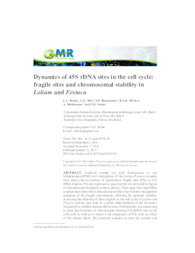Dynamics of 45S rDNA sites in the cell cycle: fragile sites and chromosomal stability in Lolium and Festuca.
Dynamics of 45S rDNA sites in the cell cycle: fragile sites and chromosomal stability in Lolium and Festuca.
Author(s): ROCHA, L. C.; SILVA, G. A.; BUSTAMANTE, F. O.; SILVEIRA, R. A. D.; MITTELMANN, A.; TECHIO, V. H.
Summary: Abstract Analyses carried out with fluorescence in situ hybridization (FISH) in C-metaphases of the Lolium-Festuca complex have shown the occurrence of spontaneous fragile sites (FSs) in 45S rDNA regions. FSs are expressed as gaps but they do not result in breaks or chromosomal fragments in these species. These gaps have high DNA condensation observed as thin chromatin fibers that connect the apparent segments of the fragile chromosome, allowing for genomic stability. Assessing the behavior of these regions in the cell cycle of Lolium and Festuca species may lead to a better understanding of the dynamics that preserve stability during cell division. Furthermore, it is interesting to track the dynamics of chromosomes bearing 45S rDNA sites in the cell cycle as well as to observe the expression of FSs with no effect of the mitotic block. We observed variation in both the number and size of 45S FISH signals from the S/G2 phases of interphase and from prophase to anaphase where gaps in 45S rDNA sites also were observed. The change in the degree of condensation of the 45S site begins in the S/G2 phase and appears to be related to the transcriptional demand. Taking into account that the number of 45S rDNA sites tends to be re-established when cells reach telophase, we suggest that the chromatin fiber goes back to the normal condensation level to the anaphase (after segregation), allowing for the approximation of chromosome segments and ensuring dynamics that favor the genomic stability of these species.
Publication year: 2017
Types of publication: Journal article
Unit: Embrapa Dairy Cattle
Observation
Some of Embrapa's publications are published as ePub files. To read them, use or download one of the following free software options to your computer or mobile device. Android: Google Play Books; IOS: iBooks; Windows and Linux: Calibre.
Access other publications
Access the Agricultural Research Database (BDPA) to consult Embrapa's full library collection and records.
Visit Embrapa Bookstore to purchase books and other publications sold by Embrapa.

